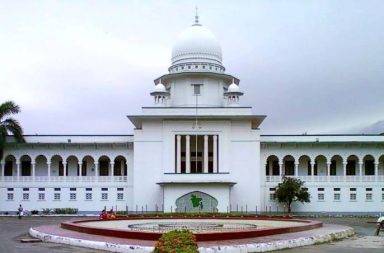By Asadullahil Galib
The full bench of the Appellate Division of the Supreme Court unanimously declared the 16th amendment of the Constitution as illegal, affirming the judgment the earlier decision of the High Court Division. By this trailblazing verdict, the power to impeach a Judge of either division of the Supreme Court remained in the hands of the President, on a report of inquiry of the Supreme Judicial Council as enshrined in art. 96 of the Constitution.
This decision was based on the doctrine of separation of powers among the three organs of the state namely Legislature, Executive and Judiciary. Our Constitution is largely found upon the doctrine of Separation of Power, which was projected to the whole world by the French Philosopher Montesquieu who, through his theory, had us to believe that assimilation of all three kinds of power in one authority, would ensue tyranny. This separation is a prerequisite to ensure independence of higher judiciary as enshrined in art. 95 of the Constitution. Moreover, separation of judiciary is a provision of our Constitution under art. 22, as such, a part of the ‘Basic Structure’ of the Constitution too under art. 7B. Consequently, the Parliament, although got power to amend any provision of the Constitution under art. 142, but it cannot make any amendment which withers away any provision of basic structure under art. 7B.
People from different corners of the legal arena including intellectuals, practitioners, teachers, students mostly welcomed the verdict. The Government, however, became outstandingly astonished to, and seriously dissatisfied, with the verdict. The key argument placed by the Govt. was centered around the ‘Impeachment-Power’, which was vested in the Parliament under the original Constitution of 1972, and subsequently forwarded to the President through the Fourth Amendment of the Constitution in 1975.
Separation of Power and the Basic Structure Doctrine
The doctrine puts a restriction on the Parliament to provide, through amendment of the Constitution, any power which makes any FR nugatory or withers away any of the ‘Constitutional Pillars’; the essence is that amending power does not include destruction power. The doctrine was formally introduced in Bangladesh in 8th amendment case, wherein the Supreme Court declared that amendment unconstitutional, because it provided for six permanent benches of the High Court Division outside the Capital by amendment of art. 100, consequently, it destructed the ‘one integrated Supreme Court’ or ‘oneness of the Supreme Court’ which is the Basic Structure of the Constitution. The doctrine was further applied in the 5th and 7th amendments cases declaring the ‘Martial Law Proclamations’ as void, also in the 13th amendment case declaring the provisions for ‘Caretaker Government System’ as unconstitutional. The doctrine is, to a greater extent, good and appreciable for it gives protection of basic schemes of the Constitution. However, there is no parameter to measure what particular provision would be a basic structure or what the actual number of basic structure would be; which ultimately depends on interpretation of the Apex Judiciary. The situation changed by introduction of the new art. 7B through 15th amendment of the Constitution, which expressly termed at least 50 articles of the constitution as basic structures. Again, the ultimate recourse lies to the Highest Judiciary’s interpretation. This uncertainty creates a biggest room for transgression by judiciary, because the interpretation of basic structure doctrine has becoming subjective varying from situation to situation; for example, when the 13th Amendment was challenged in 1996, the Apex Court termed the ‘caretaker government system’ as accessory to one of the basic structure i.e. Election. But, the same Judiciary held ultimately such system as destructive to the ‘Democracy’ (another basic structure) and hence unconstitutional.
However, it is undeniable, both before and after introduction of 7B, that ‘Separation and Independence of the Judiciary’ is the basic structure of the Constitution. Therefore, if any constitutional amendment violates such independence, that will be struck down for being void.
Assessing the Constitutional Amendments under Basic Structure Doctrine
One can put forward a question that if there is a conflict between the provision of the original Constitution of 1972 and that of the present Constitution as amended, what would be the possible wayout? There is no clear-cut answer as to the issue. However, it may be assumed from the judgment of 5th amendment case, the provision of the original Constitution of 1972 would prevail, because the Supreme Court denied to accept the meaning of ‘socialism’ as ‘economic and social justice’ and kept it, as it was originally, intact. The Government has been severely shocked from the verdict of 16th Amendment case and it expressed that ‘how did a provision of Military dictatorship (provision of Supreme Judicial Council through Martial Law Proclamation) become the basic structure of the Constitution, abrogating the original one (power of impeachment of Judges in the hands of Parliament)”?. The answer came from the Judiciary that the article 96 in the original Constitution was a ‘historical mistake’ which was rectified by the 5th Amendment of the Constitution through introduction of the ‘Supreme Judicial Council’.
Earlier Mistake of the Parliament
When the Supreme Court declared, earlier in 2009, the 5th amendment as unconstitutional, it condoned all the previous proceedings, Executive-actions and legislations as past and closed. Nevertheless, there was an absolute necessity to bring a constitutional amendment for saving those prevalent provisions of 5th Amendment, which lost their legality by the Judgment. Thereafter when the Parliament brought the 15th Amendment in the Constitution in 2011, keeping many previous provisions and omitting the rest, it could’ve repealed the provision of ‘Supreme Judicial Council’ from the Constitution with no possibility of facing any judicial confrontation; the plot was very much convenient then. However, The parliament didn’t do so.
The Long Game of Theory vs Practice
If it is accepted that the provision of original Constitution should prevail, the 16th Amendment is good. But, according to the opinions of Amicus Curies and Judges of the verdict, it’ll always create political influences on judges disturbing judicial independence and put a constant fear on them too. Therefore, vesting of such power in the Parliament, as in India and England, will not be justifiable, because the situations of democracy of Bangladesh and those countries are different.
It may be argued that the Judiciary, being an organ of the State, is independent and separate theoretically but not practically. Because, the Judiciary, being subordinate to the President, is subordinate to the decision of the Prime Minister too, who is also the chief of the ruling political party.
Measuring the Independence of Judiciary
There are some issues in constitutional law which can not be answered in one word, for example, what would be the meaning of ‘gross misconduct’ under articles 52 and 96. The concept of ‘Independence of Judiciary’ is one of such issues; one cannot define how much independence is necessary for ensuring justice. But, the bottom level is certain that there shouldn’t be assimilation or transgression, instead, there should be check and balance. Montesquieu did actually specify that “the independence of the judiciary has to be real, and not apparent merely”. “The judiciary was generally seen as the most important of powers, independent and unchecked, and also was considered dangerous”.
Reality of Constant Fear
While the power in the hands of Parliament during 1973-1975, there was no single record of impeachment of Judge, through exercising such power. However, there are considerable record of such impeachment by President through the recommendations of Supreme Judicial Council during the Martial Law period. Some of the Judges were removed through impeachment very unceremoniously.
Concluding Remarks
Respecting the decision of the Supreme Court in 16th amendment case, I must say that the verdict has been a cherished dream for the persons of legal arena specifically and for the people generally. However, the verdict has created a doctrinal or theoretical hegemony regarding the application of original Constitution for ascertaining the Basic Structure. The intellectuals will further consider that ‘is there any scope to keep the original Constitution remain applicable?. The most convenient way will be to keep both simultaneously for both of ‘independence’ and ‘check & balance’ are necessary. Therefore, the Parliament and Supreme Judicial Council can act concurrently in association of each other; and there may be two enactments for detailed provisions namely ‘The Judges (Appointment) Act, and ‘The Judges (Inquiry) Act’. Otherwise, this verdict will be a precedent for abrogating any provision of the original Constitution in future days through exercising political malafide and terming as ‘historical mistake’.



